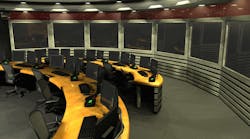Cisco on Wednesday announced the launch of a new software solution aimed at streamlining control room operations for cities around the globe. Dubbed "City Operations Center," the software provides users with a single pane of glass approach to integrate video feeds, as well as applications and sensor data and overlay it onto geographic map information.
According to Munish Khetrapal, managing director, solutions and product management for Smart+Connected Communities at Cisco, the increasing population that is projected in cities over the next several decades is expected to place an even greater burden on not just their security infrastructure, but also on traffic, parking, waste management, and a myriad of other functions that are critical to the day-to-day operations of any city.
"Think about what happens when there is an emergency situation and there are multiple agencies coordinating the response," said Khetrapal. "How does the traffic department know where there is an emergency or how does the (power utility) know that they need to help and support another agency when there is an incident? Having that type of agency collaboration makes cities much more efficient and as you increase the population and infrastructure demand; you need to have that kind of collaboration."
However, actually enabling this level of collaboration between city agencies or departments is much easier said than done when you factor in all of the various sensors that have to be tied together within a command center, the most demanding of which is video surveillance.
Khetrapal said that camera feeds are responsible for consuming over 70 percent of the network traffic coming into most city command centers and that figure can quickly increase as systems scale. To address this issue, the City Operations Center software provides users with the ability to reduce bandwidth through its intelligent Pixel-on-Demand technology which can be used to efficiently manage system resources and process camera images in at full frame rate and with the highest image resolutions.
"The technology that we’re bringing together helps to shrink some of that (bandwidth) requirement," added Khetrapal. "What Pixel-on-Demand technology does is transmits the change in pixels. For example, if you have a camera looking at a specific road, 90 percent or 80 percent of that road is not moving, there is only 20 percent of that road where there is a change happening. What (this technology) does is without compression or the loss in compression that would happen when all of this traffic is occurring, is it transmits the change in pixels only while the rest of the video remains static and dynamically resizes it which allows you to achieve up to 95 percent savings in bandwidth. So, if you’re paying $100,000, you would probably end up paying $5,000 or $10,000 in bandwidth costs from a city operations standpoint."
Another challenge that Khetrapal said cities commonly deal with in trying to integrate multiple sensors and systems together is that the standard operating procedure environment that characterizes many operations centers is very "application-centric" with each application or department having their own dedicated screen and operator. The Open User Interface (UI) provided by City Operations Center, however, enables end users to have that single pane of glass view.
"They are looking at their own screens and they are trying to collaborate with each other, but that doesn’t work well when you’ve got so many agencies and all of these different moving parts in a city," explained Khetrapal. "What you want to have is an ability to superimpose select data (on a screen) in a user-centric or city-centric view. With (City Operations Center) you have a geospatial map, you have sensors and you have video feeds all superimposed on top of each other. Creating that is, technologically, not an easy thing to do."
Lastly, the City Operations Center software provides users with a Remote Desktop Solution (RDS) the enables real-time monitoring and control on remote servers. According to Khetrapal, the software has already been implemented in several locations including Korea South-East Power (KOSEP).
The solution was used by KOSEP to integrate 1,500 surveillance cameras along with maps, alarm system and power generation data. The improved operation stability provided by City Operations Center enabled the electric utility to achieve more than $700,000 in savings by predicting 207 error cases in three months.
"Any anomalies detected in our facility are immediately reported with various types of data including video for accurate situation assessment," Hongseok Kim, deputy general manager in the Technical Research Team at KOSEP, said in a statement. "We can now take preventative actions to any possible incidents that may cause severe damages upon the plant's assets, environment and staff around the facility. Since deployment, the monitoring system has reported 207 anomalies, resulting in savings equivalent to $770,000."


